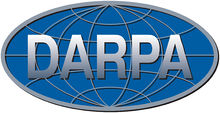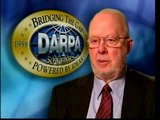From Wikipedia, the free encyclopedia
 |
|
| Agency overview | |
|---|---|
| Formed | 1958 |
| Headquarters | Arlington, Virginia, U.S. |
| Employees | 240 |
| Annual budget | 2.8 billion[1] |
| Agency executive | Arati Prabhakar, Director[2] |
| Parent agency | Department of Defense |
| Website | www.darpa.mil |

DARPA's former headquarters in the Virginia Square neighborhood of Arlington. This agency recently moved to 675 North Randolph Street, near the Ballston Common Mall.
DARPA began as the Advanced Research Projects Agency (ARPA) created in 1958 by President Dwight D. Eisenhower for the purpose of forming and executing research and development projects to expand the frontiers of technology and science and able to reach far beyond immediate military requirements.[3] The administration was responding to the Soviet launching of Sputnik 1 in 1957, and ARPA's mission was to ensure U.S. military technology be more sophisticated than that of the nation's potential enemies. From DARPA's own introduction:[4]
DARPA’s original mission, established in 1958, was to prevent technological surprise like the launch of Sputnik, which signaled that the Soviets had beaten the U.S. into space. The mission statement has evolved over time. Today, DARPA’s mission is still to prevent technological surprise to the US, but also to create technological surprise for our enemies.ARPA was renamed to "DARPA" (for Defense) in March 1972, then renamed "ARPA" in February 1993, and then renamed "DARPA" again in March 1996.
DARPA is independent from other more conventional military research and development and reports directly to senior Department of Defense management. DARPA has around 240 personnel (about 140 technical) directly managing a $3 billion budget. These figures are "on average" since DARPA focuses on short-term (two to four year) projects run by small, purpose-built teams.
Contents
History
Early history
The creation of DARPA was authorized by President Eisenhower in 1958 for the purpose of forming and executing research and development projects to expand the frontiers of technology and science, and able to reach far beyond immediate military requirements.,[3] the two relevant acts being the Supplemental Military Construction Authorization (Air Force)[5] (Public Law 85-325) and Department of Defense Directive 5105.15, in February 1958. Its creation was directly attributed to the launching of Sputnik and to U.S. realization that the Soviet Union had developed the capacity to rapidly exploit military technology.Additionally, the political and defense communities recognized the need for a high-level Department of Defense organization to formulate and execute R&D projects that would expand the frontiers of technology beyond the immediate and specific requirements of the Military Services and their laboratories. In pursuit of this mission, DARPA has developed and transferred technology programs encompassing a wide range of scientific disciplines which address the full spectrum of national security needs.
From 1958 to 1965, ARPA's emphasis centered on major national issues, including space, ballistic missile defense, and nuclear test detection. During 1960, all of its civilian space programs were transferred to the National Aeronautics and Space Administration (NASA) and the military space programs to the individual Services.
This allowed ARPA to concentrate its efforts on the Project Defender (defense against ballistic missiles), Project Vela (nuclear test detection), and Project AGILE (counterinsurgency R&D) Programs, and to begin work on computer processing, behavioral sciences, and materials sciences. The DEFENDER and AGILE Programs formed the foundation of DARPA sensor, surveillance, and directed energy R&D, particularly in the study of radar, infrared sensing, and x-ray/gamma ray detection.
ARPA at this point (1959) played an early role in Transit (also called NavSat) a predecessor to the Global Positioning System (GPS).[6] "Fast-forward to 1959 when a joint effort between DARPA and the Johns Hopkins Applied Physics Laboratory began to fine-tune the early explorers’ discoveries. TRANSIT, sponsored by the Navy and developed under the leadership of Dr. Richard Kirschner at Johns Hopkins, was the first satellite positioning system."[7][8]
During the late 1960s, with the transfer of these mature programs to the Services, ARPA redefined its role and concentrated on a diverse set of relatively small, essentially exploratory research programs. The agency was renamed the Defense Advanced Research Projects Agency (DARPA) in 1972, and during the early 1970s, it emphasized direct energy programs, information processing, and tactical technologies.
Concerning information processing, DARPA made great progress, initially through its support of the development of time-sharing (all modern operating systems rely on concepts invented for the Multics system, developed by a cooperation among Bell Labs, General Electric and MIT, which DARPA supported by funding Project MAC at MIT with an initial two-million-dollar grant).[9]
DARPA supported the evolution of the ARPANET (the first wide-area packet switching network), Packet Radio Network, Packet Satellite Network and ultimately, the Internet and research in the artificial intelligence fields of speech recognition and signal processing, including parts of Shakey the robot.[10] DARPA also funded the development of the Douglas Engelbart's NLS computer system and The Mother of All Demos; and the Aspen Movie Map, which was probably the first hypermedia system and an important precursor of virtual reality.
Later history
The Mansfield Amendment of 1973 expressly limited appropriations for defense research (through ARPA/DARPA) to projects with direct military application. Some[who?] contend that the amendment devastated American science, since ARPA/DARPA was a major funding source for basic science projects of the time; the National Science Foundation never made up the difference as expected.The resulting "brain drain" is also credited with boosting the development of the fledgling personal computer industry. Many young computer scientists fled from the universities to startups and private research labs like Xerox PARC.
Between 1976 and 1981, DARPA's major projects were dominated by air, land, sea, and space technology, tactical armor and anti-armor programs, infrared sensing for space-based surveillance, high-energy laser technology for space-based missile defense, antisubmarine warfare, advanced cruise missiles, advanced aircraft, and defense applications of advanced computing. These large-scale technological program demonstrations were joined by integrated circuit research, which resulted in submicrometer electronic technology and electron devices that evolved into the Very Large Scale Integration (VLSI) Program and the Congressionally mandated charged particle beam program.
Many of the successful programs were transitioned to the Services, such as the foundation technologies in automatic target recognition, space based sensing, propulsion, and materials that were transferred to the Strategic Defense Initiative Organization (SDIO), later known as the Ballistic Missile Defense Organization (BMDO), now titled the Missile Defense Agency (MDA).
Recent history
During the 1980s, the attention of the Agency was centered on information processing and aircraft-related programs, including the National Aerospace Plane (NASP) or Hypersonic Research Program. The Strategic Computing Program enabled DARPA to exploit advanced processing and networking technologies and to rebuild and strengthen relationships with universities after the Vietnam War. In addition, DARPA began to pursue new concepts for small, lightweight satellites (LIGHTSAT) and directed new programs regarding defense manufacturing, submarine technology, and armor/anti-armor.On October 28, 2009 the agency broke ground on a new facility in Arlington, Virginia a few miles from the Pentagon.[11]
In fall 2011, DARPA hosted the 100-Year Starship Symposium with the aim of getting the public to start thinking seriously about interstellar travel.[12]
| DARPA History | ||||||
|---|---|---|---|---|---|---|
|
Organization
Key characteristics
According to former DARPA Director Tony Tether and W. B. Bonvillian (“Power Play”, W. B. Bonvillian, The American Interest, Volume II, p 39, November–December 2006), DARPA's key characteristics to be replicated to reproduce DARPA's success are:[13]- Small and flexible: DARPA has only about 140 technical professionals; DARPA presents itself as “100 geniuses connected by a travel agent.”[14]
- Flat organization: DARPA avoids hierarchy, essentially operating at only two management levels to ensure the free and rapid flow of information and ideas, and rapid decision-making.
- Autonomy and freedom from bureaucratic impediments: DARPA has an exemption from Title V civilian personnel specifications, which provides for a direct authority to hire talents with the expediency not allowed by the standard civil service processes.
- Eclectic, world-class technical staff and performers: DARPA seeks great talents and ideas from industry, universities, government laboratories, and individuals, mixing disciplines and theoretical and experimental strength. DARPA neither owns nor operates any laboratories or facilities, and the overwhelming majority of the research it sponsors is done in industry and universities. Very little of DARPA’s research is performed at government labs.
- Teams and networks: At its very best, DARPA creates and sustains great teams of researchers from different disciplines that collaborate and share in the teams’ advances.
- Hiring continuity and change: DARPA’s technical staff is hired or assigned for four to six years. All key staff i.e. Office Directors and Program Managers are rotated to ensure constant infusion of fresh thinking and perspectives.
- Project-based assignments organized around a challenge model: DARPA organizes a significant part of its portfolio around specific technology challenges. It foresees innovation-based capabilities and then works back to the fundamental breakthroughs required to make them possible. Although individual projects typically last three to five years, major technological challenges may be addressed over longer time periods, ensuring patient investment on a series of focused steps and keeping teams together for ongoing collaboration.
- Outsourced support personnel: DARPA extensively leverages technical, contracting, and administrative services from other DoD agencies and branches of the military. This provides DARPA the flexibility to get into and out of an area without the burden of sustaining staff, while building cooperative alliances with its “agents.” These outside agents help create a constituency in their respective organizations for adopting the technology.
- Outstanding program managers: The best DARPA program managers have always been freewheeling zealots in pursuit of their goals. The Director’s most important task is to recruit and hire very creative people with big ideas, and empower them.
- Acceptance of failure: DARPA pursues breakthrough opportunities and is very tolerant of technical failure if the payoff from success will be great enough.
- Orientation to revolutionary breakthroughs in a connected approach: DARPA historically has focused not on incremental but radical innovation. It emphasizes high-risk investment, moves from fundamental technological advances to prototyping, and then hands off the system development and production to the military services or the commercial sector.
- Mix of connected collaborators: DARPA typically builds strong teams and networks of collaborators, bringing in a range of technical expertise and applicable disciplines, and involving university researchers and technology firms that are often not significant defense contractors or beltway consultants.
Current program offices
DARPA has seven program offices, all of which report to the DARPA director:- The Adaptive Execution Office (AEO) is one of two new DARPA offices created in 2009 by the previous DARPA Director, Regina Dugan. Its four project areas include technology transition, assessment, rapid productivity and adaptive systems.
- The Defense Sciences Office (DSO) vigorously pursues the most promising technologies within a broad spectrum of the science and engineering research communities and develops those technologies into important, radically new military capabilities.[15]
- The Information Innovation Office (I2O) aims to ensure U.S. technological superiority in all areas where information can provide a decisive military advantage.
- The Microsystems Technology Office (MTO) mission focuses on the heterogeneous microchip-scale integration of electronics, photonics, and microelectromechanical systems (MEMS). Their high risk/high payoff technology is aimed at solving the national level problems of protection from biological, chemical and information attack and to provide operational dominance for mobile distributed command and control, combined manned/unmanned warfare, and dynamic, adaptive military planning and execution.
- The Strategic Technology Office (STO) mission is to focus on technologies that have a global theater-wide impact and that involve multiple Services.[16]
- The Tactical Technology Office (TTO) engages in high-risk, high-payoff advanced military research, emphasizing the "system" and "subsystem" approach to the development of aeronautic, space, and land systems as well as embedded processors and control systems. This research includes an effort within the TTO to develop a small satellite launch vehicle.[17] This vehicle is under development by AirLaunch LLC.[18] This is part of the Force Application and Launch from Continental United States (FALCON) effort.
- The Biological Technologies Office (BTO) fosters, demonstrates, and transitions breakthrough fundamental research, discoveries, and applications that integrate biology, engineering, and computer science for national security. Created in April 2014 by DARPA director Aratir Prabhakar, taking programs from the MTO and DSO divisions.[19]
Former offices
- Information Awareness Office: 2002–2003
- The Advanced Technology Office (ATO) researched, demonstrated, and developed high payoff projects in maritime, communications, special operations, command and control, and information assurance and survivability mission areas.[citation needed]
- The Special Projects Office (SPO) researched, developed, demonstrated, and transitioned technologies focused on addressing present and emerging national challenges. SPO investments ranged from the development of enabling technologies to the demonstration of large prototype systems. SPO developed technologies to counter the emerging threat of underground facilities used for purposes ranging from command-and-control, to weapons storage and staging, to the manufacture of weapons of mass destruction. SPO developed significantly more cost-effective ways to counter proliferated, inexpensive cruise missiles, UAVs, and other platforms used for weapon delivery, jamming, and surveillance. SPO invested in novel space technologies across the spectrum of space control applications including rapid access, space situational awareness, counterspace, and persistent tactical grade sensing approaches including extremely large space apertures and structures.
- The Information Systems Office (ISO) in the 1990s developed system applications of advanced information technologies. It was a predecessor to the Information Exploitation Office.[citation needed]
- The Electronic Systems Technology Office combined areas of the Defense Sciences Office and the Defense Manufacturing Office. This new office will focus on the boundary between general-purpose computers and the physical world, such as sensors, displays and the first few layers of specialized signal-processing that couple these modules to standard computer interfaces.
- The Computing Systems Technology Office combined functions of the old Information Sciences and Tactical Technology office. The office "will work scalable parallel and distributed heterogeneous computing systems technologies," DoD said.[citation needed]
- The Software and Intelligent Systems Technology Office and the Computing Systems office will have responsibility associated with the Presidential High-Performance Computing Initiative. The Software office will also be responsible for "software systems technology, machine intelligence and software engineering."
- The Land Systems Office was created to develop advanced land vehicle and anti-armor systems, once the domain of the Tactical Technology Office
- The Undersea Warfare Office combined areas of the Advanced Vehicle Systems and Tactical Technology offices to develop and demonstrate submarine stealth and counterstealth and automation.
- The Transformational Convergence Technology Office (TCTO) mission was to advance new crosscutting capabilities derived from a broad range of emerging technological and social trends, particularly in areas related to computing and computing-reliant subareas of the life sciences, social sciences, manufacturing, and commerce. The TCTO was folded into the I2O in 2010.[16]
- The Information Processing Techniques Office (IPTO) focused on inventing the networking, computing, and software technologies vital to ensuring DOD military superiority. The IPTO was combined with TCTO in 2010 to form the I2O.[citation needed]
Notable fiction
ARPA/DARPA is well known as a high-tech government agency, and as such has many appearances in popular fiction. Some realistic references to ARPA in fiction are in Tom Swift and the Visitor from Planet X (DARPA consults on a technical threat),[42] in episodes of television program The West Wing (the ARPA-DARPA distinction), the television program Numb3rs[43] (DARPA research into creating the first self-aware computer), and in the motion picture Executive Decision (use of a one-of-a-kind experimental prototype in an emergency). It is also in the movie Chain Reaction, starring Keanu Reeves and Morgan Freeman.[citation needed]Other references often attribute to DARPA an operational or political role, in addition to its high-tech responsibilities. Examples are the Matthew Reilly books Temple and Hell Island, the James Rollins Sigma Force book series, and the video game series Metal Gear Solid, as well as the video games Infamous, Vanquish, and Tom Clancy's Splinter Cell: Conviction. DARPA also appears in three novels by Andy McDermott, The Search for Excalibur, The Covenant of Genesis and The Empire of Gold.[citation needed] The institution Dharma Initiative in the series Lost bear a resemblance to DARPA more than in the name.
See also
General
- History of the Internet
- People: Barry Boehm, Vint Cerf, Douglas Engelbart, Robert Fano, Anup K. Ghosh, James Hendler, Bob Kahn, JCR Licklider, John Poindexter, Larry Roberts, Robert Sproull, Ivan Sutherland, Bob Taylor, Gio Wiederhold.
Sister organizations
- Advanced Research Projects Agency-Energy (ARPA-E)—Department of Energy
- Homeland Security Advanced Research Projects Agency (HSARPA)—Department of Homeland Security
- Intelligence Advanced Research Projects Activity (IARPA)—Director of National Intelligence
International equivalents
- Russian Foundation for Advanced Research Projects in the Defense Industry—Russia
- Defence Science and Technology Laboratory—United Kingdom
- Defence Research and Development Organisation—India
- Defence Science and Technology Organisation—Australian
- Defence Research and Development Canada—Canadian
- Tekes—the Finnish Funding Agency for Technology and Innovation—Finland




No comments:
Post a Comment